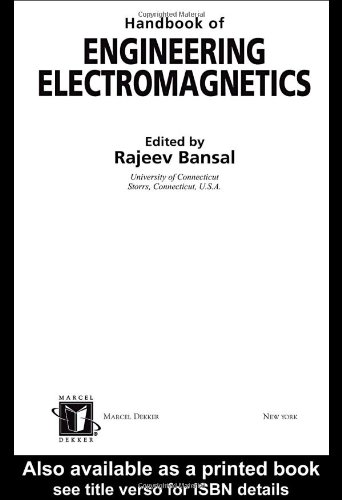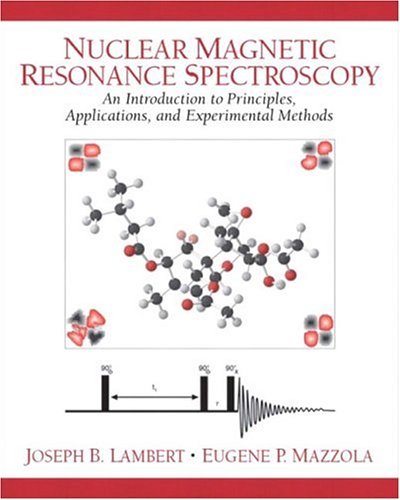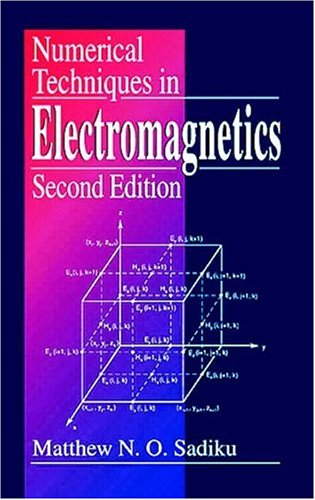Rajeev Bansal0824756282, 9780824756284, 9780203026021
Table of contents :
dk1126fm……Page 1
Handbook of ENGINEERING ELECTROMAGNETICS……Page 2
Preface……Page 5
Contents……Page 7
Contributors……Page 9
Appendix B: Some Units and Conversions……Page 0
1.1.1. Lorentz Force Equation……Page 11
1.1.2. Material Parameters and Constitutive Relations……Page 13
䄀洀瀀攀爀攀ᤠ猀 䌀椀爀挀甀椀琀愀氀 䰀愀眀……Page 17
䜀愀甀猀猀ᤠ 䰀愀眀 昀漀爀 琀栀攀 䔀氀攀挀琀爀椀挀 䘀椀攀氀搀……Page 18
Law of Conservation of Charge……Page 19
1.2.2 Maxwell’s Equations in Differential Form and the Continuity Equation……Page 22
1.2.3. Boundary Conditions……Page 25
1.2.4. Electromagnetic Potentials and Potential Function Equations……Page 27
1.2.5. Power Flow and Energy Storage……Page 28
1.3.1. Classification of Fields……Page 30
Electrostatic Fields and Capacitance……Page 31
Magnetostatic Fields and Inductance……Page 35
Electromagnetostatic Fields and Conductance……Page 37
Electroquasistatic Fields……Page 41
Magnetoquasistatic Fields……Page 43
Quasistatic Fields in a Conductor……Page 44
Wave Equation and Solutions……Page 47
Distributed Circuit Concept……Page 54
1.3.5. Hertzian Dipole Fields via the Thread of Statics–Quasistatics–Waves……Page 57
REFERENCES……Page 62
2.1. INTRODUCTION……Page 63
2.2. THE ELECTROQUASISTATIC REGIME……Page 64
2.3. DISCRETE AND DISTRIBUTED CAPACITANCE……Page 66
2.5. THE ORIGINS OF ELECTROSTATIC CHARGE……Page 67
2.7. INDUCTION CHARGING……Page 70
2.8. DIELECTRIC BREAKDOWN……Page 71
2.9. CORONA DISCHARGE……Page 73
2.10. CHARGES AND FORCE……Page 74
2.11. PARTICLE CHARGING IN AIR……Page 76
2.13. ELECTROSTATIC COATING……Page 79
2.14. ELECTROSTATIC PAINT SPRAYING……Page 80
2.15. ELECTROPHOTOGRAPHY……Page 81
2.16. ELECTROSTATIC PRECIPITATION……Page 82
2.17. FIELD AND CHARGE MEASUREMENT……Page 85
2.18. ELECTROSTATIC FIELD MILL……Page 86
2.19. NONCONTACTING VOLTMETER……Page 87
2.20. MICROMACHINES……Page 90
2.22. ELECTROSTATIC DISCHARGE AND CHARGE NEUTRALIZATION……Page 93
REFERENCES……Page 95
3.1. INTRODUCTION……Page 98
3.2.2. The Biot–Savart Law……Page 99
3.2.3. Units: How Large is a Tesla?……Page 100
3.2.6. Magnetic Flux……Page 101
㌀⸀㈀⸀㜀⸀ 䄀洀瀀攀爀攀ᤠ猀 䰀愀眀 椀渀 嘀愀挀甀甀洀……Page 102
3.2.8. Magnetic Field in Materials……Page 103
㌀⸀㈀⸀㤀⸀ 䜀攀渀攀爀愀氀椀稀攀搀 䄀洀瀀攀爀攀ᤠ猀 䰀愀眀 愀渀搀 䴀愀最渀攀琀椀挀 䘀椀攀氀搀 䤀渀琀攀渀猀椀琀礀……Page 104
3.2.10. Macroscopic Currents Equivalent to a Magnetized Material……Page 105
3.2.11. Boundary Conditions……Page 106
3.2.12. Basic Properties of Magnetic Materials……Page 107
3.2.13. Magnetic Circuits……Page 110
3.3.1. Basic Properties of Magnetic Force on a Charged Particle (the Lorentz Force)……Page 112
Charged Particle Moving in a Uniform Magnetic Field……Page 113
The Hall Effect……Page 114
Helmholtz Coils……Page 116
Magnetic Force in a Loudspeaker……Page 118
Magnetic Field of a Straight Wire……Page 119
Magnetic Field of a Toroidal Coil……Page 121
Magnetic Field of a Stripline……Page 122
3.3.5. Measurements of Basic Properties of Magnetic Materials……Page 123
3.3.6. Magnetic Storage……Page 124
3.3.7. Magnetic Circuits……Page 127
3.3.8. Nuclear Magnetic Resonance (NMR) and Magnetic Resonance Imaging (MRI)……Page 129
REFERENCES AND FURTHER READING……Page 131
4.1. INTRODUCTION……Page 132
4.2.1. The Induced Electric Field……Page 133
㐀⸀㈀⸀㈀⸀ 䘀愀爀愀搀愀礀ᤠ猀 䰀愀眀 漀昀 䔀氀攀挀琀爀漀洀愀最渀攀琀椀挀 䤀渀搀甀挀琀椀漀渀……Page 134
4.2.3. Potential Difference and Voltage in a Time-varying Electric and Magnetic Field……Page 135
4.2.4. Self-inductance and Mutual Inductance……Page 136
4.2.5. Energy and Forces in the Magnetic Field……Page 138
4.3.1. Magnetic Coupling……Page 140
㐀⸀㌀⸀㈀⸀ 䰀攀渀琀稀ᤠ猀 䰀愀眀……Page 141
4.3.4. The Skin Effect and the Proximity and Edge Effects……Page 142
4.3.5. Limitations of Circuit Theory……Page 145
4.3.6. Superconducting Loops……Page 146
4.4.1. An AC Generator……Page 147
4.4.2. Induction Motors……Page 148
4.4.4. Measurement of AC Currents……Page 149
4.4.5. Problems in Measurement of AC Voltage……Page 150
4.4.6. Readout of Information Stored on a Magnetic Disk……Page 151
4.4.7. Transformers……Page 152
Mutual Inductance Between a Toroidal Coil and a Wire Loop Encircling the Toroid……Page 154
Mutual Inductance of Two Crossed Two-wire Lines……Page 155
Self-inductance of a Thin Solenoid……Page 156
Self-inductance of a Coaxial Cable……Page 159
External Self-inductance of a Thin Two-wire Line……Page 160
Self-inductance and Mutual Inductance of Two Windings over a Toroidal Core……Page 161
Flat Multiconductor Cable……Page 162
一攀甀洀愀渀渀ᤠ猀 䘀漀爀洀甀氀愀 昀漀爀 䔀砀琀攀爀渀愀氀 匀攀氀昀ⴀ椀渀搀甀挀琀愀渀挀攀 漀昀 愀 圀椀爀攀 䰀漀漀瀀……Page 163
4.6.2. Losses in Ferromagnetic Materials Due to Hysteresis and Eddy Currents……Page 164
Ferrite Anechoic Chambers for EMC/EMI Testing……Page 165
4.6.5. Force of an Electromagnet……Page 166
4.6.6. Comparison of Electric and Magnetic Pressure……Page 167
4.7.1. Mutual Inductance Between Monophase Cables Laid on the Bottom of the Sea……Page 168
4.7.3. Rough Calculation of Induced Voltages in a Human Body Due to Currents in Power Lines……Page 169
REFERENCES……Page 170
5.1. WAVE EQUATIONS AND CHARACTERISTICS……Page 172
5.1.2. Dispersion……Page 174
5.1.4. Group Velocity……Page 175
5.1.5. Polarization……Page 177
㔀⸀⸀㘀⸀ 倀漀礀渀琀椀渀最ᤠ猀 吀栀攀漀爀攀洀……Page 178
5.1.7. Boundary Conditions……Page 180
5.1.8. Wave Reflection……Page 181
5.2. FREE-SPACE PROPAGATION MODEL……Page 183
5.3. PATH LOSS MODEL……Page 184
5.4. EMPIRICAL PATH LOSS FORMULA……Page 190
REFERENCES……Page 191
6.1. INTRODUCTION……Page 193
6.2.1. Transmission-line Parameters……Page 195
6.2.2. Transmission-line Equations for Lossless Lines……Page 196
6.2.3. General Traveling-wave Solutions for Lossless Lines……Page 197
6.3. TRANSIENT RESPONSE OF LOSSLESS TRANSMISSION LINES……Page 200
6.3.1. Reflection Coefficient……Page 201
6.3.2. Step Response……Page 202
6.3.3. Lattice Diagram……Page 204
6.3.4. Applications……Page 205
Transmission-line Junctions……Page 206
Reactive Terminations……Page 208
Nonlinear Terminations……Page 209
Time-Domain Reflectometry……Page 210
6.4.1. Characteristics of Lossy Transmission Lines……Page 212
Impedance Transformation……Page 215
Transmission Lines as Reactive Circuit Elements……Page 218
Standing Waves……Page 220
6.4.3. The Smith Chart……Page 224
6.4.4. Impedance Matching……Page 227
Quarter-wave Transformer……Page 228
Stub Matching……Page 229
6.5. FURTHER TOPICS OF TECHNOLOGICAL IMPORTANCE AND FUTURE DIRECTIONS……Page 231
6.5.3. Chip- and Package-level Interconnects……Page 232
REFERENCES……Page 233
7.2. MODE CLASSIFICATIONS……Page 235
7.3. MODAL FIELDS AND CUTOFF FREQUENCIES……Page 237
7.4. PROPERTIES OF METAL WAVEGUIDES……Page 238
7.4.2. Wave Impedance……Page 239
7.4.3. Wave Velocities……Page 240
7.4.5. Effects of Losses……Page 241
7.5. RECTANGULAR WAVEGUIDES……Page 243
7.6. CIRCULAR WAVEGUIDES……Page 246
7.7. COAXIAL-TO-WAVEGUIDE TRANSITIONS……Page 249
7.8. COMPARATIVE SURVEY OF METAL WAVEGUIDES……Page 251
7.9.1. Cylindrical Cavity Resonators……Page 253
7.9.2. Dielectric Resonators……Page 257
FURTHER INFORMATION……Page 260
8.1. INTRODUCTION TO RADIATION……Page 262
8.2. ANTENNA TERMINOLOGY……Page 263
8.3. SIMPLE ANTENNA STRUCTURES……Page 266
8.4. ANTENNA ARRAYS AND PATTERN SYNTHESIS……Page 275
8.5. SMART ANTENNAS……Page 277
8.6. ANTENNA MEASUREMENTS……Page 280
REFERENCES……Page 282
9.1.1. Introduction……Page 283
9.1.2. Basic Principles of Operation……Page 284
9.1.3. Feeding Techniques……Page 285
9.1.5. Radiation Patterns……Page 287
9.1.6. Radiation Efficiency……Page 289
9.1.7. Bandwidth……Page 292
9.1.8. Input Impedance……Page 293
9.1.9. Improving Performance……Page 294
9.2.2. Helical Antenna……Page 297
9.2.3. Frequency Independent Antennas……Page 300
9.2.4. Spiral Antennas……Page 301
9.2.5. Log-periodic Antennas……Page 305
9.3.1. Introduction……Page 308
9.3.2. Slow-wave Antennas……Page 309
Uniform Structures……Page 313
Periodic Structures……Page 316
Two-dimensional Leaky-wave Antennas……Page 318
9.4.2. Radiation from Apertures……Page 320
9.4.3. Electrically Small Rectangular Slot……Page 323
9.4.4. Rectangular Horn Antenna……Page 324
9.4.5. Reflector Antennas……Page 328
9.5.1. Array Far Fields……Page 330
9.5.2. Array Pattern Characteristics……Page 335
9.5.3. Array Gain……Page 340
9.5.4. Array Elements……Page 343
9.5.5. Phased Array Feed and Beam-forming Systems……Page 344
9.5.6. Electronic Beamsteering……Page 346
9.5.7. Mutual Coupling……Page 349
REFERENCES……Page 350
10.1. SIGNIFICANCE OF EMC TO MODERN ENGINEERING PRACTICE……Page 353
10.2.1. Elements of EM Field Theory……Page 355
10.2.2. Treatment of Signals and Sources……Page 359
10.2.3. Circuit Analysis for EMC……Page 360
10.3.1. Penetration Through Materials……Page 361
10.3.2. Penetration Through Apertures……Page 363
10.3.3. Conducted Penetrations……Page 365
10.3.4. Radiation and Cross Talk……Page 369
10.5. EMC STANDARDS AND TECHNIQUES……Page 376
REFERENCES……Page 379
11.1. INTRODUCTION AND HISTORICAL BACKGROUND……Page 383
11.2. TERMS AND CONCEPTS……Page 384
11.2.1. Resolution and Accuracy……Page 388
11.2.2. PRF and Maximum Range……Page 389
11.2.3. Pulse Integration and Doppler Frequency……Page 390
11.2.4. Angular and Elevation Scan……Page 391
11.2.5. Analog-to-Digital Conversion (ADC) Process……Page 393
11.2.6. Range-Doppler Ambiguities……Page 394
11.2.7. Pulse Compression and Matched Filter……Page 395
11.2.8. CFAR Detection and Decision Making……Page 396
11.2.9. False Alarm Probability and ROC……Page 397
11.3. PROPAGATION ENVIRONMENT AND PATH LOSS PREDICTION……Page 398
11.4. RADAR EQUATION……Page 402
11.4.1. Noise-Limited Detection……Page 405
11.5.1. Target……Page 407
11.5.2. Noise……Page 409
11.5.3. Clutter……Page 410
11.5.4. Interference……Page 413
11.6. PARAMETER SELECTION FOR SURVEILLANCE RADAR……Page 414
11.7. HFSW RADAR-BASED WIDE-AREA SURVEILLANCE……Page 416
REFERENCES……Page 420
Other Fundamental Radar Books……Page 421
12.1.1. Definition of the Wireless Communication System……Page 422
12.1.2. Frequency Spectrum for Wireless Communications……Page 423
12.1.3. Noise……Page 424
12.1.4. Main Propagation Characteristics……Page 425
Path Loss……Page 427
Long-Term or Slow Fading……Page 428
Short-Term or Fast Fading……Page 429
12.1.6. Narrowband and Wideband Signal Representations……Page 430
12.1.7. Characterization of Terrain Configurations……Page 432
12.1.8. Various Propagation Situations in Built-up Areas……Page 433
Radiation Pattern……Page 434
Dipole Antennas……Page 438
12.3. PATH LOSS PREDICTION MODELS IN VARIOUS OUTDOOR COMMUNICATION LINKS……Page 439
Reflection Coefficients……Page 440
Line-of-Sight (LOS) Two-Ray Model……Page 441
12.3.3. Path Loss in Clutter (NLOS) Conditions……Page 443
Street-Multislit-Waveguide Model……Page 447
Two-Dimensional Model of Straight Rows of Buildings……Page 448
伀欀甀洀甀爀愀ᤠ猀 䔀洀瀀椀爀椀挀愀氀 䴀漀搀攀氀……Page 450
圀愀氀昀椀猀挀栀ጠ䤀欀攀最愀洀椀 䴀漀搀攀氀……Page 453
Statistical Model of Path Loss in Outdoor Communication Links……Page 454
Path Loss (L)……Page 456
12.4. FADING PHENOMENA IN WIRELESS OUTDOOR COMMUNICATION LINKS……Page 457
Delay Spread Parameters……Page 458
Coherence Bandwidth……Page 459
Doppler Spread and Coherence Time……Page 460
12.4.2. Types of Fading……Page 461
12.4.3. Mathematical Modeling of Fast Fading……Page 462
Rayleigh Multipath Fast Fading Statistics……Page 465
Rician Multipath Fading Statistics……Page 466
Gaussian Fading Statistics……Page 467
12.5. LINK BUDGET DESIGN IN WIRELESS OUTDOOR COMMUNICATION SYSTEMS……Page 470
12.5.1. Link Budget Accounting Shadowing Effects (Slow Fading)……Page 471
12.5.2. Link Budget Design of the Channels with Fast Fading……Page 473
12.6.1. Main Characteristics of a Cell……Page 474
12.6.2. Cell Design Strategy……Page 476
12.6.3. Cochannel Interference Concept……Page 479
City with Regularly Planned Streets……Page 481
City with Nonregularly Planned Streets……Page 482
REFERENCES……Page 484
Chapter 13: Satellite Communication Systems……Page 487
Geostationary Earth Orbit (GEO) Satellites……Page 488
Low Earth Orbit (LEO) Satellites……Page 489
13.1.2. Frequency Bands……Page 490
13.1.3. Basic Satellite Components……Page 492
13.2. ORBITAL CHARACTERISTICS……Page 494
13.3. PROPAGATION CHARACTERISTICS……Page 496
13.4.1. VSAT Networks……Page 499
13.4.2. Fixed Satellite Service……Page 501
13.4.3. Mobile Satellite Service……Page 502
13.4.4. Satellite Radio……Page 506
13.4.5. Satellite-Based Internet……Page 507
REFERENCES……Page 509
14.1.1. Fiber-Optic System……Page 511
14.1.2. Optical Spectrum……Page 512
Light-Emitting Diodes……Page 513
Laser Diodes……Page 514
14.1.4. Photodetectors……Page 515
14.2.1. Wave Properties……Page 516
14.2.2. Pulse Transmission……Page 519
㐀⸀㈀⸀㌀⸀ 匀渀攀氀氀ᤠ猀 䰀愀眀 愀渀搀 吀漀琀愀氀 刀攀昀氀攀挀琀椀漀渀……Page 521
14.2.4. Reflection at a Boundary……Page 523
14.2.5. Gaussian Beams……Page 526
14.2.6. Electromagnetic Cavity……Page 528
14.3.1. Slab Waveguide……Page 531
14.3.2. TE Mode Chart……Page 532
14.3.3. TM Mode Chart……Page 536
14.3.4. Mode Field Patterns……Page 537
14.3.5. Asymmetric Waveguide……Page 538
14.3.6. Modal Distortion……Page 539
14.4.1. Step-Index Fiber……Page 540
14.4.2. Graded-Index Fiber……Page 545
14.4.3. Attenuation……Page 548
14.4.4. Waveguide Dispersion and Polarization-Mode Dispersion……Page 549
REFERENCES……Page 551
15.1. INTRODUCTION……Page 553
15.2.1. High-Frequency Methods……Page 555
15.2.2. Integral Equations……Page 558
15.2.3. Finite Difference Methods……Page 561
15.2.4. Finite Element Method (FEM)……Page 566
15.2.5. Other Techniques for Finding the Fields……Page 568
15.3.1. Model-Based Parameter Estimation (MBPE)……Page 569
15.3.2. Optimization……Page 570
15.3.3. Wavelets……Page 573
15.3.4. Hybrid Methods……Page 576
15.4.1. Programming Languages……Page 578
15.4.3. Verification and Validation……Page 579
15.5. CONCLUSIONS……Page 580
REFERENCES……Page 581
16.2. ELECTRIC AND MAGNETIC FIELDS……Page 583
16.2.1. Interaction Mechanisms……Page 584
16.2.2. Laboratory Studies……Page 585
16.2.4. Human Studies……Page 586
Childhood Leukemia……Page 587
16.2.6. Safety Standards and Protection Guidelines……Page 588
16.3.1. Thermal Effects……Page 589
16.3.3. Toxicological Studies……Page 590
Brain Functions……Page 591
Traffic Radar Devices……Page 592
Radio and Television Transmitters……Page 593
16.3.8. Safety Standards and Exposure Guidelines……Page 594
16.4.1. Theoretical Dosimetry……Page 597
16.4.3. Instrumentation……Page 598
16.4.4. In-Head Dosimetry of Mobile Phones……Page 599
REFERENCES……Page 602
17.2. THERMAL ABLATION THERAPIES……Page 608
17.2.1. EM Energy Propagation in Tissue……Page 609
17.2.2. Temperature Elevation in Tissue……Page 613
17.2.4. Angioplasty……Page 614
17.2.5. Benign Prostate Hyperplasia……Page 615
17.3. HYPERTHERMIA CANCER TREATMENT……Page 616
17.4. HYPOTHERMIA ELIMINATION……Page 617
17.5. TISSUE IMAGING……Page 619
17.6. NONINVASIVE AND REMOTE SENSING……Page 621
17.8. BONE AND SOFT TISSUE HEALING……Page 623
REFERENCES……Page 624
18.1. INTRODUCTION……Page 633
18.2.2. Relaxation Theory……Page 634
18.2.4. Relaxation Mechanisms in Biological Substances……Page 637
18.3.1. Basic Methods……Page 639
Perturbation Technique……Page 641
Sample-Terminated Coaxial Cavity……Page 644
Open Resonators……Page 647
18.3.3. Open-Ended Transmission Line……Page 648
Lumped-Capacitance Method……Page 649
Full Wave Modeling……Page 650
18.3.4. Free-Space (Quasioptical) Measurement Techniques……Page 651
18.3.5. Two-Port Network Analyzer Measurement/Extraction……Page 653
18.3.7. Other Methods……Page 655
18.4.1. Open-Ended Coaxial Probe……Page 656
One-Port Measurement System……Page 657
One-Port Calibration……Page 658
Modeling Issues……Page 659
Higher Order Modes……Page 660
18.4.2. A Two-Port Microstrip Measurement System……Page 661
Test Fixture Setup……Page 662
Higher Order Modes……Page 663
Modeling and Extraction Procedures……Page 664
Measurement and Extraction of the Complex Permittivity……Page 665
Measurement Sensitivity and Uncertainty……Page 666
18.4.3. Tissue Cole-Cole Parameters……Page 669
REFERENCES……Page 672
Appendix A: Some Useful Constants……Page 679
Appendix B: Some Units and Conversions……Page 680
C.3. SCALAR AND VECTOR FIELDS……Page 681
C.4. VECTOR ADDITION AND SUBTRACTION……Page 682
C.5. POSITION AND DISTANCE VECTORS……Page 683
C.6.1. Scalar (Dot) Product……Page 684
C.7. The Cylindrical Coordinate System……Page 685
C.8. THE SPHERICAL COORDINATE SYSTEM……Page 686
Vector Interconversion Strategy……Page 688
C.10.1. Divergence……Page 689
C.10.3. Curl……Page 690







Reviews
There are no reviews yet.